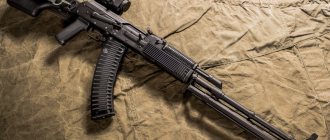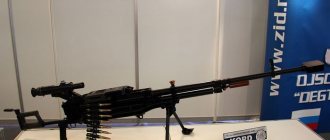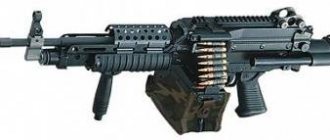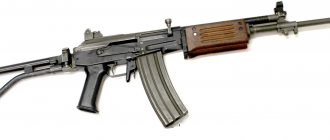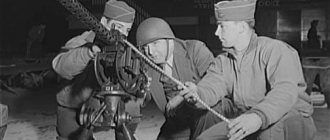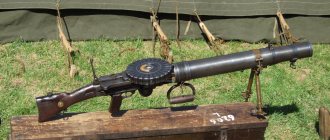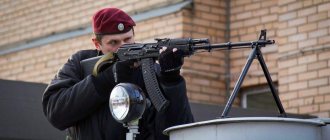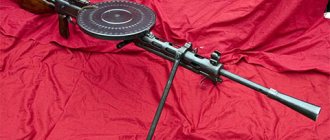| This article includes a list of common references, but it remains largely unverified because It lacks a sufficient number of relevant embedded links . |
Light machine gun
| Johnson M1941 LMG | |
| Type | Light machine gun |
| Place of origin | United States |
| Service history | |
| In service | 1940–1961 |
| Used | See Users |
| Wars |
|
| Production history | |
| Developed | 1940 |
| Unit cost | US$265 (1941; equivalent to US$4,606 in 2019) |
| Produced | 1940–1945 |
| No built | 9 500 |
| Options | M1941 M1944 |
| Characteristics | |
| Weight | 13 lb (5.9 kg) |
| Length | 42 inches (1100 mm) |
| Barrel length | 22 inches (560 mm) |
| Cartridge | .30-06 Springfield |
| Action | Short recoil |
| Rate of fire | 300–900 rpm variable |
| starting speed | 2,800 ft/s (853.6 m/s) |
| Feeding system | 20-round detachable box magazine, single stack |
M1941 Johnson Light Machine Gun
, also known as
Johnson
and
the Johnny Gun
, [1] was an American recoil-controlled machine gun developed in the late 1930s by Melvin Johnson. It had the same operating principle and many parts as the M1941 Johnson Rifle and M1947 Johnson Automatic Carbine.
Design[edit]
The M1941 light machine gun was designed by a Boston lawyer and Marine Corps Reserve captain named Melvin Johnson Jr. His goal was to build a semi-automatic rifle that would be superior to the one adopted by the army. By the end of 1937, he had designed, built and successfully tested both a semi-automatic rifle and a prototype light machine gun. Each shared a significant number of physical characteristics and common parts, and both operated on the short recoil rotating bolt principle. He took parts from other guns, replaced them, and created the M1941 light machine gun.
Curved single-column Johnson magazine attached to the left side of the receiver; The company's brochures list a 20-round magazine as standard. In addition, the weapon could be loaded using a removable clip in the ejection port or with single cartridges fed into the breech. The rate of fire was adjusted from 200 to 600 rounds per minute. Two versions were built: the M1941 with a wooden stock and metal bipod, and the M1944 with a tubular steel stock and a wooden monopod.
The design provides that the recoil force moves along with the mass of moving parts of the weapon in a straight line to the gunner's shoulder. Although this design minimized muzzle rise, the sights had to be positioned higher above the bore.
Johnson LMG in use
The weapon has many parallels with the German FG 42. Both are fed from the left side, and both fire from an open bolt in automatic mode and from a closed bolt in semi-automatic mode. Both weapons were awkward to carry loaded, with a side magazine; The Johnson had a particularly long single-column magazine, a feature that tended to throw the weapon off balance. Despite these similarities, there is no evidence that either weapon influenced the design of the other in any way. Both weapons attempted to solve similar problems and made similar decisions.
Prototype semi-automatic shotguns, 20 rounds fed, [ edit
] were also derived from Johnson LMG. The M1947 Johnson Automatic Carbine is an example. There was also a belt feed option. [2]
Johnson M1941 and M1944 light machine gun (USA)
Johnson M1941 light machine gun.
Johnson M1944 light machine gun.
| Caliber | .30-06 (7.62×63) |
| Weight | 6.48 kg |
| Length | 1066 mm |
| Barrel length | 558 mm |
| Nutrition | magazine, 20 rounds |
| Rate of fire | 300 - 900 rounds per minute, adjustable |
By 1941, Melvin C. Johnson, a retired US Marine officer, had developed a self-loading rifle and a light machine gun (automatic rifle), based on the same short-throw automatic design. Johnson's M1941 light machine gun was noticeably lighter than the Browning M1918A2 automatic rifle, and due to the competent use of automatic weapons with a short barrel stroke, it had relatively low recoil, and, importantly, a quick-change barrel. The US Army at that time was convinced that army weapons should come exclusively from the bowels of the army itself, or rather, army arsenals, and showed minimal interest in commercial developments that competed (tried to compete) with “military” systems. As a result, the first buyers of rifles and light machine guns were the government of the Dutch West Indies, which was trying to arm its colonial troops in view of the threat of Japanese occupation. Since this occupation occurred before the execution of the contract, most of the weapons of the Johnson system were purchased by the US government, more precisely, by the US Marine Corps (MCC), which was chronically lacking modern weapons. Johnson's machine guns were handed over to the USMC parachute units. After the rapid disbandment of the airborne regiments, the cunning Marines managed to “exchange” a significant number of these light and fairly reliable machine guns for the latest plastic explosives from the Army Rangers, who, in turn, successfully used the Johnsons until the end of the war. Johnson himself presented a simplified version of his machine gun under the designation M1944 in 1944, but the army this time chose to “ignore” this model. It should be noted that Johnson's machine guns bore a certain resemblance to the German FG 42 automatic rifle; their main difference is the lower perceived recoil (due to the use of a movable barrel and slightly larger mass) and a quick-change barrel, which, if there was a spare, allowed more intense “machine-gun” fire.
The Johnson M1941 light machine gun is an automatic weapon with an air-cooled quick-change barrel. The automatic machine gun uses the recoil of the barrel during its short stroke. The barrel is locked by a rotary bolt having eight radial lugs that engage with the barrel breech. The machine gun allowed automatic and single fire. Firing was carried out from a closed bolt with single shots and from an open bolt with automatic fire. The cartridges are fed from single-row box magazines with a capacity of 20 cartridges adjacent to the left. A feature of the machine gun’s power system was that, thanks to the location of the magazine below the axis of the barrel bore, it was possible to reload it without separation from the weapon, from ordinary rifle clips inserted into a special window on the right wall of the receiver. The machine gun was standardly equipped with a folding bipod attached to the barrel casing. The modified machine gun of the 1944 model had a lightweight design with a metal butt and a single-legged bipod under the barrel.
Users[edit]
Johnson sold small quantities of Johnson LMGs to the US Army and Marine Corps. [3]
During World War II, Allied special forces demanded a more portable, lighter, and more accurate automatic rifle that would provide stopping power equivalent to the American BAR. As a result, this machine gun was adapted as a replacement for the BAR for commandos operating behind Axis lines. The First Special Service Force, raised jointly with men from Canada and the United States (the famous Devil Brigade), traded the Marines 125 new Johnson light machine guns for plastic explosives. These were used in place of BARs, but as they wore out and were lost in combat, they were replaced by BARs.
The Johnson LMG was used by the Philippine Army and Philippine Constabulary during World War II under Japanese military occupation from 1942 to 1945 and in the post-war period from 1945 to 1960, including during the Hukbalahap Rebellion (1946-1954) and the Philippine Expeditionary Forces for Korea or PEFTOK (1950-1955).
Shortly after the 1948 Arab–Israeli War, the predecessor of the Israel Defense Forces, the Haganah, developed a close copy of Johnson's light machine gun, the Dror, in .303 British and 7.92×57mm Mauser calibers. Israeli forces found that the Dror was susceptible to jamming due to sand and dust, and the weapon was withdrawn from production after a short period of service. Ernesto "Che" Guevara particularly used Johnson in the Cuban Revolution.
Johnson M1941 self-loading rifle (USA)
Johnson M1941 rifle.
View of the magazine and receiver of the M1941 rifle. The window for loading the magazine with guides for clips, located between the magazine and the bolt cocking handle, is clearly visible. The window is closed with a spring-loaded lid.
Diagram of the M1941 rifle drum magazine.
Caliber
: .30-06 (7.62×63 mm)
Length
: 1156 mm
Barrel length
: 558 mm
Weight
: 4.3 kg without cartridges
Magazine
: 10 cartridges
American Melvin C. Johnson created his first self-loading rifle in 1938, and in the same year he handed it over to the US Army for testing. Testing continued until early 1940, when the Johnson rifle was rejected due to lower reliability than the M1 Garand rifle already in service. Nevertheless, Johnson began small-scale production of his rifle, and in 1941 he gave it the “military” designation M1941. That same year, the administration of the Dutch West Indies, concerned about the threat of Japanese occupation, ordered 70,000 of his M1941 rifles from Johnson, but by the time most of the order was ready, the West Indies had already been occupied by the Japanese. During the same period, the United States entered the war with Japan, and the US Marine Corps bought about 30,000 M1941 rifles from Dutch representatives in the United States, since there were not enough M1 Garand rifles. At the end of the war, most of the remaining M1941 rifles were returned to the Dutch.
Due to its design features, the M1941 rifle had both advantages and disadvantages compared to the M1 Garand rifle. The advantages included a large magazine capacity as well as the ability to reload it at any time with individual cartridges or from clips from the M1903 rifle. The M1941 rifle could easily be disassembled into two parts (barrel and stock with mechanisms), which made it possible to carry it in the form of a compact bale, and therefore carry it with you during a parachute drop (M1941 rifles were used by parachute units of the USMC). The disadvantages of the M1941 rifle were greater sensitivity to contamination due to the automatic action with a moving barrel, the inability to use a standard bayonet, and less availability of spare parts.
The Johnson M1941 rifle is built on an automatic basis using recoil energy with a short barrel stroke. The barrel is locked by a rotating bolt with eight lugs, behind a coupling screwed onto the barrel shank. The cartridges are fed from an integral drum magazine with a capacity of 10 cartridges. The magazine is loaded through a special window on the right side of the weapon, below the window for ejecting cartridges. The magazine window has guides for plate clips (5-round clips from a Springfield M1903 rifle were used). The magazine could be loaded both with the bolt open and closed. There were variants of the rifle with a conventional box magazine, but they are very rare. The rifle stock is made of wood, made of two parts (stock with neck and fore-end), the perforated barrel casing is made integral with the receiver. The sight is diopter, adjustable in range. The rifle could be equipped with a special needle bayonet of small mass, which did not have a separate handle.
Consequences[edit]
Melvin Johnson continued to develop small arms. In 1955, he was asked to help Fairchild/ArmaLite (unsuccessfully) promote the Eugene Stoner AR-10 rifle with the U.S. Department of Defense and later with ArmaLite and the Colt Manufacturing Company as an advocate for the AR-15. Armalite relied heavily on Johnson's efforts, and the AR-15 used a bolt design similar to Johnson's M1941 design. The AR-15 is still produced by many manufacturers, as is its derivative, the M16 rifle. One of Johnson's last post-war ventures into firearms was a 5.7mm version of the M1 Carbine, also known as the "Spitfire". [4]
Users[edit]
| This section requires additional links for verification . |
- Canada: Used by Canadian soldiers as part of the Special Forces [5].
- Malaysia: Formerly used by the Royal Malaysian Police, now on display at the Police Museum. [6]
- Philippines
- Great Britain
- United States
Non-state actors[edit]
- July 26 movement
Notes[edit]
- Rottman, Gordon L. (2002). World War II United States Marine Corps Order of Battle: Ground and Air Units in the Pacific War, 1939-1945. Greenwood Publishing Group. paragraph 516. ISBN 978-0-313-31906-8.
- "Johnson Belt Machine Guns". February 7, 2014
- Pikula, Sam (Major), The Armalite AR-10, 1998
- Barnes, Frank S., Cartridges of the World, DBI Books, 1989
- https://www.forgottenweapons.com/james-d-julia-johnson-lmg-history-disassembly/
- https://www.sadefensejournal.com/wp/royal-malaysia-police-museum/
Rifles, carbines, shotguns
Johnson M1941. Self-loading rifle. (USA)
Johnson M1941 is an American self-loading rifle during World War II.
Melvin Maynard Johnson created his first self-loading rifle in 1938 and in the same year handed it over to the US Army for testing. Testing continued until early 1940, when the Johnson rifle was rejected due to lower reliability than the M1 Garand rifle already in service. However, Johnson began small-scale production of his rifle at a private company founded for this purpose, and in 1941 he gave it the “military” designation M1941. In the same year, the administration of the Dutch East Indies, concerned about the threat of Japanese occupation, ordered 70 thousand of his M1941 rifles from Johnson. By March 1942, when most of the order was ready, the East Indies were already occupied by the Japanese. In the same year, the United States entered the war with Japan, and the US Marine Corps bought about 20-30 thousand M1941 rifles from Dutch representatives in the USA, since the Marine Corps was chronically short of M1 Garand rifles. The rifle was briefly used by the US Navy, and at the end of the war, most of the remaining M1941 rifles were returned to the Dutch East Indies (now Indonesia). Also, a number of rifles were delivered to Chile.
Johnson M1941. Self-loading rifle. (USA)
The Johnson self-loading rifle works on the principle of using recoil energy with a short barrel stroke. The barrel has four right-hand rifling. Locking the barrel bore is achieved by engaging the eight lugs of the rotating bolt cylinder with the breech screwed onto the barrel.
The magazine is integral, drum type, holding 10 rounds. The magazine is loaded through a special window on the right side of the weapon, below the window for ejecting cartridges. The magazine window has guides for plate clips (5-round clips from a Springfield M1903 rifle were used). The magazine could be loaded both with the bolt open and closed.
There were variants of the rifle with a conventional box magazine, but they are very rare. The rifle stock is wooden, made of two parts (stock with a neck and fore-end), the barrel casing is perforated. The sight is diopter, adjustable in range.
The rifle could be equipped with a special needle bayonet of small mass, which did not have a separate handle.
Johnson M1941. Self-loading rifle. (USA)
Due to its design features, the M1941 rifle had both advantages and disadvantages compared to the M1 Garand rifle. The advantages included a large magazine capacity, as well as the ability to reload it at any time with individual cartridges or from clips from the M1903 repeating rifle. In addition, the M1941 rifle was distinguished by good shooting accuracy (the effective range and accuracy of fire of the M1941 and M1 Garand were approximately the same) and low recoil (according to some sources, its recoil was only 1/3 of the recoil of the M1 Garand rifle). Its production was less labor-intensive and cheaper. The M1941 rifle could easily be disassembled into two parts (barrel and stock with mechanisms), which made it possible to carry it in the form of a compact bale, and therefore carry it with you during a parachute drop (M1941 rifles were used by parachute units of the USMC). The disadvantages of the M1941 rifle were greater sensitivity to contamination due to the automatic action with a moving barrel, the inability to use a standard bayonet, and less availability of spare parts. Johnson's rifle also proved to be less reliable and more prone to failure than the M1 Garand. Usage
The rifle was in service with the US Marine Special Parachute Corps, which used the M1941 rifle and light machine gun based on it as standard weapons until rearmament with the M1 Garand in 1944.
Johnson M1941. Self-loading rifle. (USA)
Characteristics:
- Weight, kg: 3.9 without cartridges;
- Length, mm: 1160;
- Barrel length, mm: 559;
- Cartridge: 7.62×63 mm;
- Caliber: 7.62;
- Operating principles: short barrel stroke;
- Rate of fire, rounds/min: 30;
- Initial bullet speed, m/s: 855;
- Sighting range, m: 1000;
- Type of ammunition: drum integral magazine for 10 rounds;
- Sight: diopter.
Books and reference books [edit]
- Johnson Jr., Melvin, Rifles and Machine Guns of the World's Armies
, Fighting Forces, 1944. - Smith, Joseph E., Small Arms of the World,
Stackpole Books, 1969. - Weeks, John, Small Arms of World War II,
Galahad Books, 1980. - Barnes, Frank K., Cartridges of the World,
DBI Books, 1989. - Pikula, Sam (Major), The Armalite AR-10,
1998. - Canfield, Bruce N., Johnson Rifles and Machine Guns,
Mowbray Publishing, 2002.


